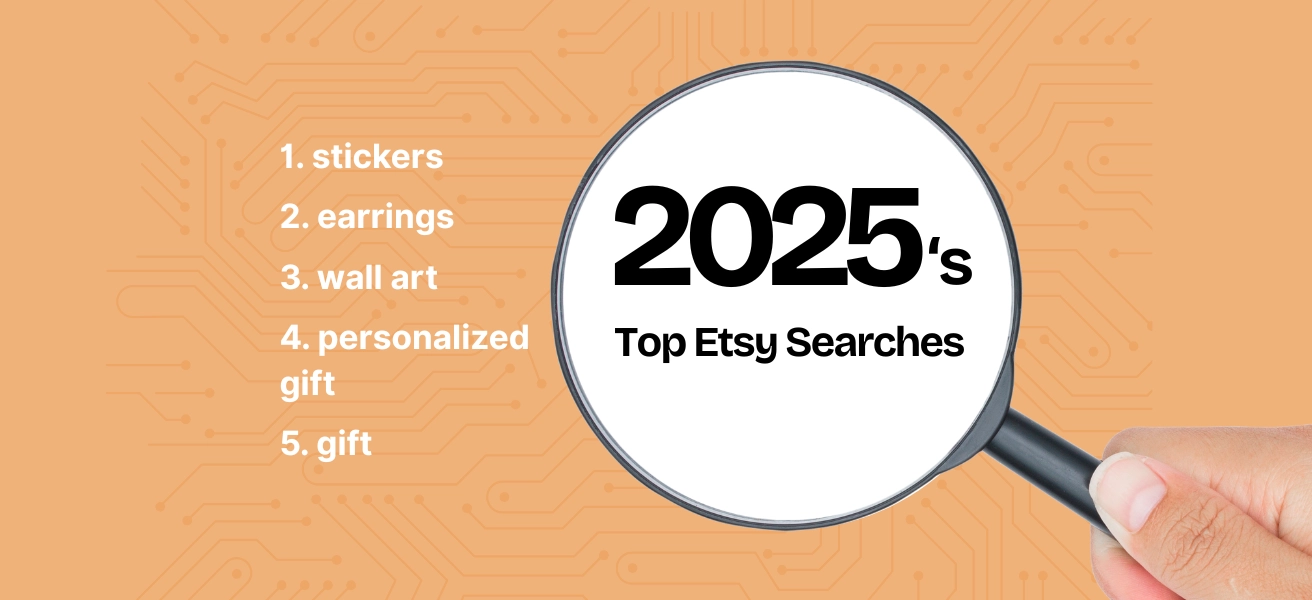Reading time: 6 minutes
Have you ever found a great keyword then realized it had too many characters to fit into an Etsy tag, so you gave up on it?
Or snooped through a competitor’s shop and been frustrated because their tags are terrible yet they’re ranking so much better than yours?

I’m Pam Duthie, I’m an Etsy U Instructor, and together let’s get this sorted!
Okay Then: What Are Tags?
Let’s begin with what tags are not.
Tags are not keywords. Keywords are what the customer types into Etsy search to find items. (And if you want to know more about keywords, I’ll be having a follow-up post about keywords here soon!)
Tags are not for the customer. Tags are part of the metadata for your Etsy listing. That is, they exist only to tell Etsy’s search engine what your item is.

Tags are what we put into a listing’s tag field to tell Etsy what our item is.
Tags and keywords are often misconstrued as meaning the same thing, as if they were synonyms, and interchangeable. Perhaps some of the confusion lies with the fact that search engines do give more weight to tags that match a keyword exactly – that is, when they have the exact same words in the same order.
Let’s say a shopper types into Etsy search canvas tote bag. If the search engine found two listings that were identical in every other way, the one that has canvas tote bag word-for-word in a tag is likely to rank higher than the listing that has tote bag canvas in a tag. But both will “rank” (appear in the search results) because Etsy’s algorithm is able to cherry pick – that is, it can single out words from your listing’s tags, title, attributes, and sub-categories you chose, then mix them to match a shopper’s keyword. Therefore, a listing with canvas tote as one tag and messenger bag as another will match for a shopper’s search for canvas bag.
Let’s Do One Together
The same applies when you have a keyword that exceeds Etsy’s 20-character limit for a tag. When you have a keyword that’s over the 20-character limit – for example, bronze and opal steampunk engagement ring – you will not be penalized in search for not having the exact match just because you have to split that keyword up into more than one tag. Why? Because every other Etsy seller has the same problem. For that long-tail keyword, everyone who uses it will have to break it up into several tags.
Right, then: let’s think about the best ways to divide that up. Bronze and opal: that’s 15 characters. Fine. Steampunk engagement: 20 characters, so that too would fit in one tag. But then that leaves ring on its own. In another quick post soon, we’ll have a talk about single-word tags. For now let’s just assume that we don’t want a single-word tag because it’s a waste of our precious tag space. So, how are we going to go about splitting this up?
Let’s turn to Keyword Explorer. If we look at the competition for bronze and opal steampunk engagement ring:

We see there is only one listing that matches our long-tail keyword. Therefore, as long as we have all of our words somewhere, we’re going rank for it. This means that, in this case, we don’t have to worry about having an exact match to a searcher’s keyword in order to be found.
And it also means we can be more strategic about how we split these terms up, because if we’re clever we might be able to deploy them in such a way that we get an exact match for more shoppers’ keywords.
Let’s begin at the beginning with bronze and opal. Here is the Keyword Explorer result:

Zilch across the board. Remember, Keyword Explorer results are based on real shoppers’ searches. These tell us nobody is searching for bronze and opal, so using it as such would just be a waste of a tag. Let’s move on.
Engagement ring is very competitive:

However, opal engagement ring has less competition:

That might be a good keyword to go for, and it’s 20 characters: yay! We have opal engagement ring then as our first tag. Next, we try bronze steampunk. And we get the same blank slate as we got for bronze and opal. Evidently it is not a search term that customers typing are into Etsy’s search bar. Let’s carry on. What about bronze ring? I look it up and see it’s searched for a bit, so it is a keyword. And it is relevant for our item; so there’s a possibility.
Let’s do steampunk ring next:

Hey, not bad! Worthwhile search volume, reasonable competition, quite good clicks and CTR (Click Through Rate), and it describes our item.
Or, say, if we knew we could easily rank for steampunk ring anyway without the exact match, what about steampunk jewelry?

Steampunk jewelry describes our item. It’s high competition but it has good search volume, clicks, and CTR, so maybe it’s worth the risk.
There we have it. We can split our original long-tail search term into three tags: opal engagement ring, bronze ring, and steampunk jewelry. Not only would we match and rank for our target keyword (bronze and opal steampunk engagement ring); it also means that we’ve got a chance of ranking for three other keywords. And with the mix-and-match nature of Etsy’s algorithm, we have a chance for turning up for some other keyword terms that we didn’t even think of, like steampunk engagement ring.
One More Thing
Now, I know you’ve heard that you shouldn’t repeat words in your tags, that in fact there is no need to do so, since Etsy’s algorithm does that “cherry picking” for you. Yet here I am, using the word ring twice. Why? Because repeating a word is actually not always a bad thing. Etsy has even shown us that in some of their own suggestions about breaking things up into keyword phrases. Several examples have a word duplicated here and there.
This is why. We want to rank for that exact term: bronze and opal steampunk engagement ring. So while it is true that in place of that second use of “ring” in our tag bronze ring we could use, say, bronze wedding band, and while it is true that doing so might give us the chance of ranking for more searches, if bronze ring describes our item best, we want to get the exact match, and the extra bit of oomph that Etsy gives to exact matches.
And there you have it. I hope that helps!
This quickie post is based on a video in my YouTube channel’s Etsy Bytes series, single-subject videos for those times when you just want to learn in little bites.

Pam Duthie
Etsy U Instructor








